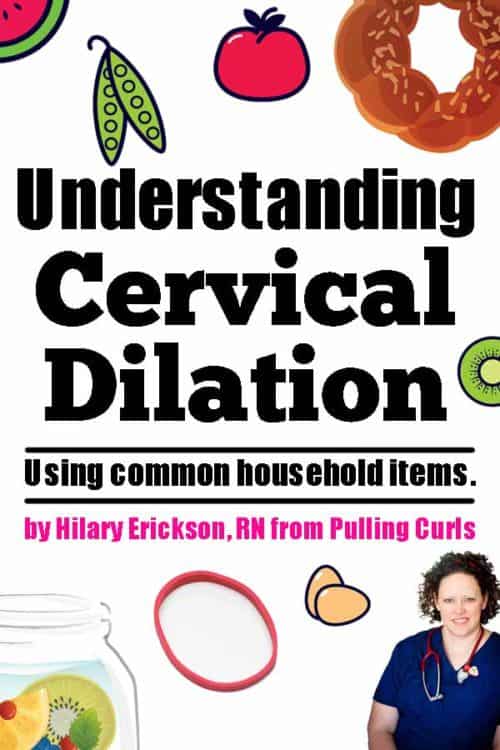Vaginal Exams are a part of pregnancy. Find out what they are used for, if they hurt, how it’s done, and what the cervical exam numbers mean when you’re in labor.

Ugh! The vag (pronounced v-a (short a) g) exam. No one looks forward to them.
The gown, the glove, the whole checking part.
No fun.
BUT, then you end up with numbers and you have no idea what they mean.
Understanding cervical dilation is imperative to understanding your labor.
Today we’re going to explore the process, tell you what the numbers mean and how you can understand them!
First off, hello! I’m Hilary — many people know me as The Pregnancy Nurse 👩⚕️. I have been a nurse since 1997 and I have 20 years of OB nursing experience, I am also the curly head behind this website Pulling Curls and The Online Prenatal Class for Couples. 🩺 I’ve done thousands of vaginal exams, and have had quite a few done on me as well. I am an expert on this area, and I’m excited to give you this info today!
One of the reasons I wrote this post, is because doctors simply don’t have the time to educate you (or choose not to) — that’s why you need a prenatal class.
The Online Prenatal class for Couples can prepare you for your confident hospital birth in just three hours time. It is….
- You can even save 10% with code PC10.
Vaginal Exams
Vaginal Exam Video
Btw, I’m not ACTUALLY doing an exam in this video — and don’t miss the rest of the article underneath it:
**Wondering if you’re in labor — don’t miss my VERY popular page – “Am I in Labor” that gives all the details!
My sister site also has a post on when cervical exams begin.
Your Cervix in Pregnancy
As a reminder, the numbers after a cervical check (or vaginal exam) consist of:
- Centimeters Dilated (given as a number): How large the opening of the cervix is
- Cervical Effacement (given as a percentage): How THIUCK your cervix is — there has to be shortening of the cervix before dleivery
- Station (given as either a negative number or a positive number between -3 to +3): how far baby’s head is into the birth canal as compared to the ischial spines.
- Cervical Consistancy — how hard or soft your cervix is — although this isn’t always mentioned to you when we tell you the exam #’s the practitioner is making note of it.
So — if your doctor says you’re 2, 90% and -3 — that means:
You’re open 2 centimeters, your cervix is pretty darn thinned out and the baby is still pretty high.
Normally, women’s cervixes thin out before they open up.
I have a whole post on station that might explain that more if your doctor says your baby is -2.
Other key points from this video:
- You have 3 holes — you’d be surprised (or, maybe you wouldn’t) how many women I have to explain that to at delivery. You have a hole you urinate out of (urethra), one you have BM’s from (rectum) and your baby exit area (vagina).
- Every practitioner (nurse, doctor, midwife) may vary a bit on their cervical exams.
- Your cervix starts as closed, and you can push when you’re 10 cm (fully dilated)
Oh, and while we’re talking about all these numbers that might mean you need to go to the hospital, grab my hospital packing list here:
What do the Exam Numbers Mean?
Your cervical check tells a few things:
Most often, we start “active labor” at around 4-6 centimeters. That means that if your cervix is less than that, it is likely that you are safe to be at home for a bit longer until your cervix is more actively dilating.
When we combine all these numbers — fetal station, dilation, effacement and consistency we create something call the bishop score. It allows us to know how prepared your cervix is to deliver your baby.
This means could we start an induction without a ton of effort, or is your body likely far away from labor.
Of course, it’s not a crystal ball — but with time your provider can see trends in specific types of cervixes and if an induction of labor would be indicated or not.
Most often they check your cervix with the use of this information would be helpful. Let’s say you’re wanting to be induced, and they’re trying to figure out if that is a good plan.
Or, you have high blood pressure, but not high enough baby has to come out NOW…. but they’re wanting to see how ready your body is to have that baby. The use of the bishop score to standardize these across practitioners is really helpful information.
How is a Vaginal Examination Done?
There are many types of pelvic exams, including the pap test.
A vaginal examination during pregnancy (often at a prenatal visit) is done with a gloved hand (most often in the hospital they will use sterile gloves), using the middle finger and first (pointer) finger. They slide them into your vaginal vault and then feel for your cervix.
If your cervix is open, they may feel your baby’s head.
At this point in time they are noting a the things we mentioned above, and also looking for any other changes like
- bloody show (are you bleeding, or any other changes in your discharge)
- cervical consistency (how hard or soft it is)
- the position of the cervix (forward or back)
- fetal position (is it a head or a bottom, plus how is the head turned).
Please remember that while these can be painful (and I always think there should be a good reason for them, a good health professional learns a LOT about you during this exam. It can’t always be termed by the numbers of the exam.
Are there risks to a pelvic exam?
A pelvic exam can start labor, so we are careful to be gentle and not do anything that might cause your uterus to contract too early (obviously, less of an issue once you are close to your due date.
There is also a risk of infection every time we go into the vaginal canal. It is a small risk, as the baby is protected by the amniotic sac (until it is broken). Once the amniotic sac is broken, the risk is higher (and your health care provider will be more mindful about when/if they need to be done).
Can you do a Vaginal Exam Yourself?
Frankly, I wouldn’t try — for a few reasons:
- It would be really hard to get deep enough into your vaginal around your baby without hurting yourself
- If you haven’t ever felt a cervix before, it’s going to be hard to know what you’re feeling when you’re in labor.
However, they recommend you check your IUD strings every month, so it IS possible (as those are in your cervix)…. but I don’t know how much info you’d get if you’re a virgin examiner. It takes many exams for a nurse to know what they’re feeling.
Vaginal Exams in Labor
Things I didn’t mention in the video that might be helpful to know:
- Usually, your cervix is posterior (more towards your tailbone) when you are in early labor/not in labor and then it moves forward as you progress into labor
- Early in your pregnancy you will need to get a pap smear as well as some cultures, those are different than a cervical exam (although they’re all done in your vagina)
- When the doctor “strips your membranes” it is a vaginal exam where he takes his finger and separates the bag of waters from your cervix. This stirs up hormones and may help you into labor (you can read more about that here).
- We use a sterile glove to check you. Newflash: Your vagina isn’t sterile. However, in the medical setting we would like to keep any new bacteria out of your vagina.
- If your cervix is extremely posterior (more towards your tailbone) we may have you put your fists under your bottom, or use an overturned bed pan for you to sit on to make your cervix more reachable. All of that is normal.
- An epidural does take away the majority of the pain from a vaginal exam.
- You may bleed a little after a vaginal exam, this is normal.
Is a vaginal exam painful?
- Cervical exams can be painful, but the more you tense up, the worse they are. By relaxing those muscles you are going to be a lot more comfortable, it will be quicker and that is good news for everyone.
- Cervical exams are more painful when you are in early labor/not in labor than they are as you progress (because your pelvic floor relaxes as well as cervix moving forward making it easier to reach).
I have a whole podcast and a post on refusing cervical exams that you might find helpful:
Cervical Exam’s FAQ’s
They can feel the baby’s head (or presenting part if it’s not a head) with their fingers. With lots of experience they can sometimes tell what it is, and if it is the head, which way the baby is facing.
early in labor the cervix will be towards the back, and it will move forward as labor progresses.
The cervix is within the vagina, and is the opening to the uterus. It is not the same as the vagina
Pap exams use a speculum, and check cervical cells for any abnormal ones that might be cancerous — it is different than the pregnancy exam.
Most often no, please do let any practitioner know if you have any STI’s going on before they perform an exam. Any questions, please ask them to do an HPV test
If you have a placenta previa (where the placenta is covering the cervix) it is important that NO ONE check your cervix. You need to state this at the beginning of any healthcare interaction.
A pregnant woman’s cervix starts out hard, and thick. In order for contractions to push the baby through it, they need the cervix to soften and thin out (we call this cervical ripening)
You can use a transvaginal ultrasound to check the length and some dilation of the cervix. This is often used in the early weeks of pregnancy. However, at the end of your pregnancy, we benefit from more information than an ultrasound can give us.
Ok, that’s vaginal exams in a nutshell. BUT, how do they fit into the entire pregnancy/labor and delivery bit? Well, I’m glad you asked. I can promise you that knowing what exactly is going to happen to you in labor is going to help you feel more confident in the labor room.
Stop just getting small snippets of what to expect as you head into the home stretch of pregnancy, come join me in The Online Prenatal Class for Couples where we can help you understand from start to finish what to expect during your pregnancy.
Have you checked a birth class off your to do list✅? I have a few I recommend:
❤️ Best class for couples {per BabyList}
👩💻 Best class available on demand
⚡ Best class JUST for pain management
👶 Best Postpartum-Only Prep
❤️🧡💛💚💙💜 My favorite class is here.
Now is the time to get started!
Not sure we’re a good fit check out my free class — It’s your first step towards being your own birth boss.












Jackie says
I refused them and my midwife was totally supportive. It is unnecessary to stick a hand in my vagina!
Hilary Erickson says
Huh…. I agree if you want a hands-off birth they are unnecessary. However, vaginal exams are a necessary part of the birthing process in most cases.
Bre says
Vaginal exams are never necessary.
Hilary Erickson says
Well, I clearly disagree with this. Exactly how many babies have you delivered?
Liz says
I agree that they are usually not necessary but are considered normal and necessary by the patriarchal approach to obstetrics today. There is A LOT of research that say cervical exams are unnecessary and do not provide reliable information to the doctor and birthing mother, not to mention they providing misleading information. If you are a pregnant woman, you should know that your doctor, nurse or midwife is required to obtain informed consent before touching your private parts (Even when you are pregnant or in labor!) and you have a right to refuse a cervical exam. These are important facts that this article does not focus on.
Hilary Erickson says
I actually updated it after you talked about this. I agree that it is important, I actually have a whole podcast on saying no coming up!
Jackie says
You make it sound like you have to have a special type of birth to request that no one shoves their hand in your vagina. No, thanks. Oh, what did we ever do when there were no intervention-happy L&D nurses to shove their hands up there during birth??? It is almost always unnecessary. A SKILLED birth professional can tell how the woman is dilating based on her movements, her sounds, her pain level, the urge to push, etc.
Hilary Erickson says
Did you even read my post about how I was trained that way. Patients want to know of their progress, and in reality — sometimes you NEED to know — but otherwise I do keep my hands to myself.